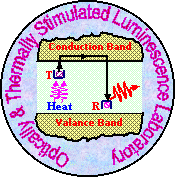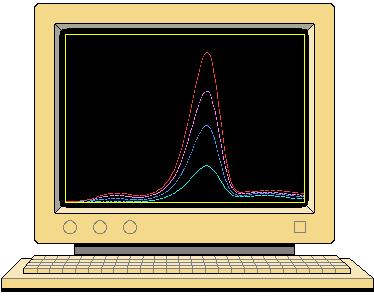
|
|

|
|
When ionising
radiation (predominantly alpha, beta or gamma radiation) interacts with an
insulating crystal lattice (such as quartz or feldspar), a net redistribution
of electronic charge takes place. Electrons are stripped from the outer shells
of atoms and though most return immediately, a proportion escape and become
trapped at ‘meta-stable’ sites within the lattice. The net charge redistribution
continues for the duration of the exposure and the amount of trapped charge
is therefore related to both the duration and intensity of radiation exposure
(ignoring saturation effects).
Even though trapped at meta-stable sites, electrons become ‘free’ once again under certain conditions (i.e.if the crystal is illuminated). While some charge traps in minerals are sensitive to heat, others are extremely sensitive to light. When an irradiated quartz or feldspar sample is exposed to visible or even infrared photons, the trapped electrons are evicted from these light-sensitive deep traps.Once liberated a free electron may become trapped once again or may return to a vacant position left by the absence of a previously displaced electron (a ‘hole’). This latter occurrence is termed ‘recombination’ and the location of the hole is described as the ‘recombination centre’. As recombination occurs, a proportion of the energy of the electron is dissipated. Depending upon the nature of the centre where recombination occurs, this energy is expelled as heat and/or light. When the crystal grain is either heated or illuminated following irradiation (the ‘dose’) the total amount of light emitted is therefore related to the number of liberated electrons, available recombination sites (the total amount of radiation energy absorbed) and the mineral's intrinsic sensitivity to radiation.They promptly are in the visible spectrum.Careful wavelength restriction of the stimulating light, combined with strict filtering of the photons emitted by the sample, allows detection of the recombination luminescence. This is the fundamental principle upon which luminescence dating is based, namely that when stimulated with light, the amount of light emitted by the crystal sample is proportional to the total absorbed radiation dose (ignoring for the moment the effects of signal saturation). |